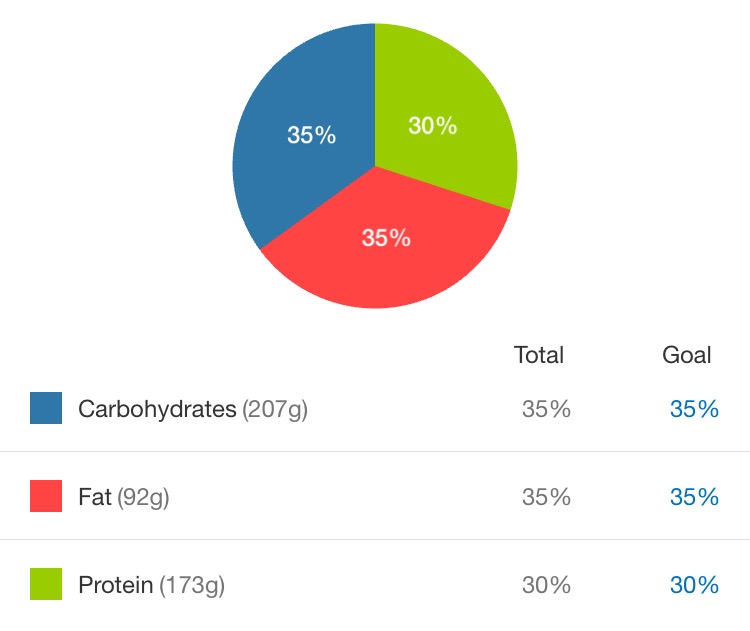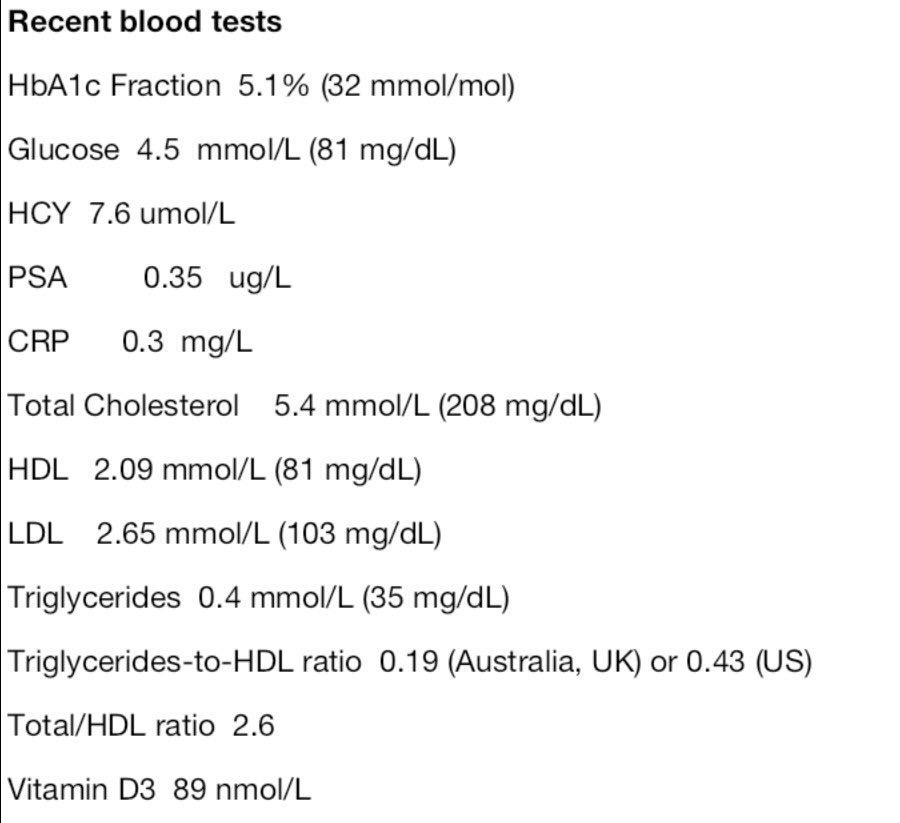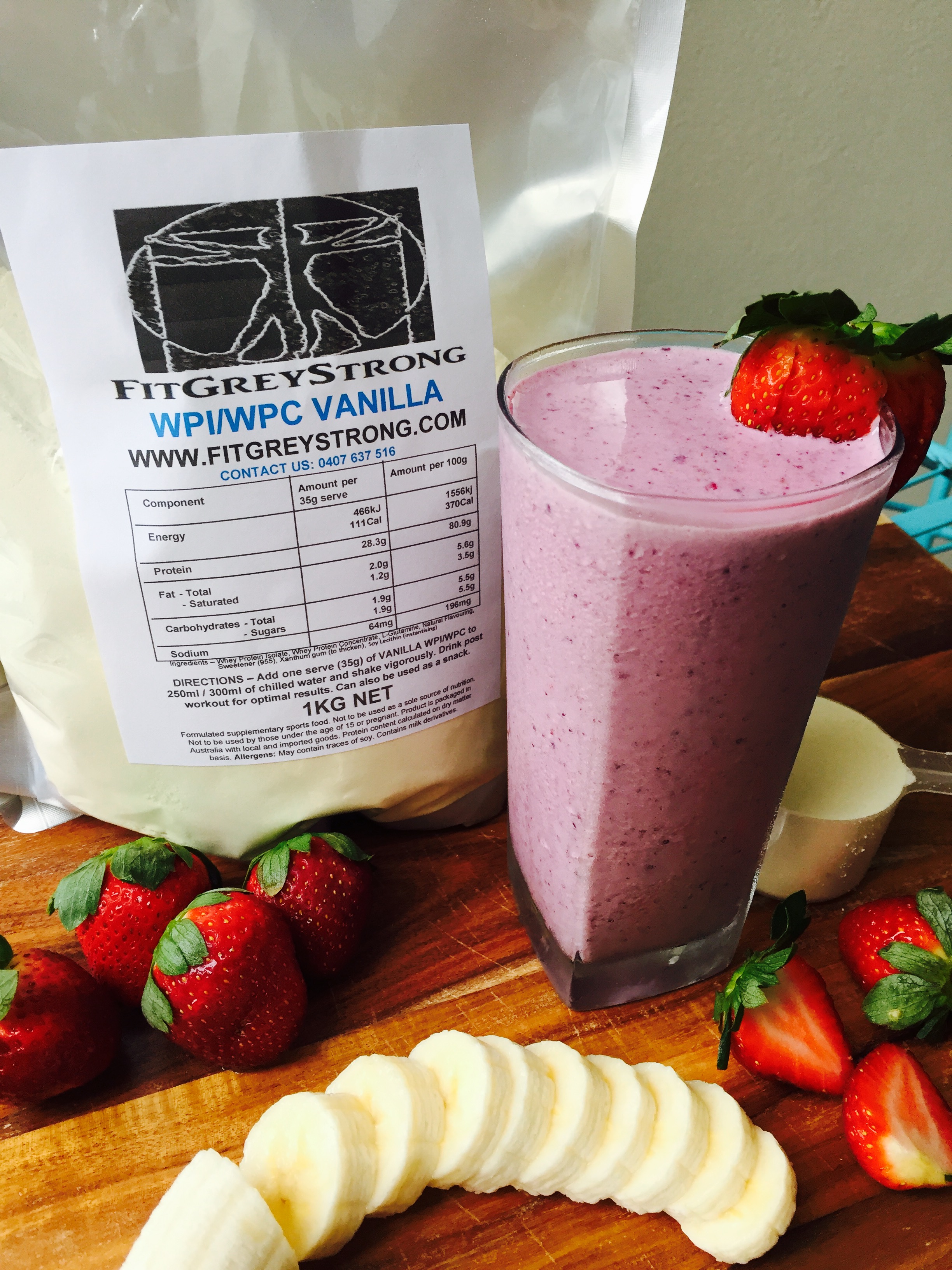This before and after 6 month “transformation” was an individual experiment (n=1), which was inspired by my professional curiosity to test the validity of 5 key claims currently purported to be fundamental for improving health and body composition that I do not entirely agree with as an Exercise Scientist.
The first 3 claims are strongly and enthusiastically advanced by those that hold the view that most, if not all human beings, should severely restrict carbohydrates. This includes some carbohydrates that have traditionally been viewed as “good carbs” like, for example, sweet potato, pumpkin, parsnips, bananas, mango, apples. The fourth claim posits that saturated fat is a key driver of increased risk and incidence of cardio- and cerebrovascular disease. The fifth claim below relates to the notion that advancing age impacts the ability to alter body composition in a meaningful way – which it does – but the point is that much can still be done if the approach taken is scientifically and evidence-based.
The claims
They are, firstly, that CICO (calories in calories out) has been scientifically debunked and is not a fundamental determinant of body weight or % body fat reduction.
Secondly, that carbohydrates are metabolically toxic and bad for your health, worsening biomarkers indicative of inflammation, CVD risk and ageing such as BP, CRP, homocysteine & triglycerides-to-HDL ratio.
Thirdly, that carbohydrates sabotage and are antithetical to body fat reduction.
Fourthly, reducing saturated fat to ≤7% of total energy intake will substantially improve dyslipidemia and reduce inflammation, and hence, morbidity and mortality rates associated with vascular-related diseases.
Fifthly, that significantly increasing lean body mass or skeletal muscle tissue, and appreciably decreasing body fat in middle-aged men or women is difficult and cannot be accomplished.
Baseline-to-endpoint anthropometry & individual characteristics (25.8.16 to 17.2.17)
Age: 49
Gender: male
Height: 1.77m (5ft 10in)
Weight: 86.6 kg (191 lb) decreased to 82.4 kg (182 Ib)
Δweight = 4.2 kg (9 Ib)
BMI: 27.6 kg/m2 decreased 26.3 kg/m2
ΔBMI = 1.3 kg/m2
Waist circumference: 92.5 cm (36¼ inches) decreased to 86.0 cm (33¾ inches)
ΔWC = 6.5 cm or 2½ inches
Body fat percentage: 17.6% decreased to 10.4%
ΔBF% = 7.2%
Fat mass: 15.2 kg (33.5 Ib) to 8.7 kg (19 Ib)
Δfat mass = 6.5 kg (14.5 Ib)
Lean body mass: 71.4 kg (159 Ib) to 73.7 kg (162 Ib)
ΔLBM = 2.3 kg (5 lb)

Insights & learnings from this experiment for Gen X’ers & Baby Boomers are as follows:
1. For improvements to be seen in health and body composition, day-to-day consistency in relation to the fundamentals (what you eat and drink, regular daily exercise and good quality sleep) are paramount.
2. The NEAT effect cannot be underestimated. NEAT or non-exercise activity thermogenesis is the energy expended for everything you do that is not related to sleeping, eating and formal exercise.
Maximising NEAT – by increasing physical movement outside of formalized exercise during the waking hours (e.g. taking the stairs not the elevator, going for a walk after dinner with the family, taking regular breaks from desk-bound work etc) and decreasing time spent in sedentary activities (e.g. watching TV, playing Xbox, surfing the net, social media etc) – has a massive effect on total daily energy expenditure.
In adults, strong evidence exists of a relationship between sedentary behavior and all-cause mortality, fatal and non-fatal cardiovascular disease, type 2 diabetes and metabolic syndrome. In addition, there is moderate evidence for incidence rates of ovarian, colon and endometrial cancers.
These relationships are independent of physical activity. What this means is even if you regularly exercise, spending a lot of your other free waking time in sedentary activities is seriously harming your long-term health.
During the last 6 months I have attempted to keep moving during the day as much as I could in addition to the formal exercise sessions I was doing.
Bottomline: get up and move around for at least a few minutes for every 30-60 minutes you spend sitting or lying around.
See more here:
https://www.ncbi.nlm.nih.gov/pmc/articles/PMC4140795/

3. Resistance training was an absolute key component of this experiment. It is essential to all Gen X’ers and Baby Boomers embarking on any lifestyle-based intervention where improved health, physical function and body composition are desired.
I could write another 10,000 words just on this point alone but I will direct you to the below links for further reading that discuss the benefits of resistance training in more detail.
See more here:

4. Aerobic exercise remains pivotal for all exercise-based programs designed to enhance health, function and body composition. Enhanced cardiorespiratory fitness (CRF) is one of the most powerful ways to reduce the risk of subsequent disease and research demonstrates significant risk reductions for all-cause, cardiac and some cancer-related mortality. The activities I performed very regularly were cycling, walking and a little bit of rowing.
However, whilst in a caloric deficit state too much emphasis on aerobic activity may lead to reductions in lean body mass (skeletal muscle). I would suggest therefore that the most effective programs have a good balance of resistive and aerobic exercise (50:50). Balance training/exercises for those over 60 would also be important given that the somatosensory system suffers a similar age-related decline in function. Balance can be improved provided exercises that challenge this system are undertaken.
5. Once a sufficient baseline level of aerobic conditioning is attained, I would suggest incorporating some HIIT (short for high intensity interval training).
My favorite HIIT session was an indoor-based cycling session that consisted of: 10-15 min warm-up @ 40-60% heart rate reserve (HRR) with 1 x 30 second effort @ rating of perceived exertion (RPE) 14-16; following warm-up I would perform 3 x 30 second sprint effort @ RPE 17-19 or 85-95% HRR with 3-5 minutes rest between efforts; then 1 x 4 minute effort @ 16-18 RPE or 80-85% HRR with 4 minutes rest then; 1 x 30 seconds sprint (intensity as above) with 3-5 minutes rest; 1 x 4 minutes effort (intensity as above); cool down 10 minutes & stretch.
There is an increasing body of evidence to show that HIIT is a potent, effective, time-efficient and safe form of exercise which dramatically improves many health and fitness components including but not limited to increased cardiopulmonary fitness, reductions in cardiometabolic risk factors and some preliminary data suggesting that it can attenuate the rate at which our cells age.
Interestingly, there is little consensus on whether HIIT is effective to facilitate improvements in body composition independently of dietary changes which reduce energy intake. Several recent systematic reviews and meta-analyses came to conclusions at odds to one another thus leaving this author somewhat perplexed by these disparities.
HIIT should only be performed once there is sufficient baseline conditioning but it is now accepted and utilised in many chronic disease conditions and to great effect.
http://www.heartlungcirc.org/article/S1443-9506(15)00258-9/pdf
https://www.ncbi.nlm.nih.gov/pubmed/22694349
Indoor cycling HIIT efforts
6. I would suggest that using the concepts of periodisation and polarization of physical exercise and training are beneficial to those that have a good foundation of fitness.
Periodisation is a training concept and is applied in practice by coaches of elite athletes and/or sporting teams. Whilst it can be quite elaborate and complex at the very elite level, for the purposes of this blog and those interested in applying such ideas to their exercise plan/program, it is simply the alternation of heavier or harder periods/days of exercise/training with a recovery or lighter day/week of physical activity. What should be remembered is that you can’t smash out high-intensity exercise sessions day in day out. Such an approach will spell disaster and lead to a training implosion where you’ll either get injured, sick or burnt out. It should be noted that much of the research that has explored periodisation versus no periodisation in non-elite adults tends to show that no further benefit is achieved. Providing planned periods of recovery and rest, I believe though, are critical to successful long-term adherence and fitness/health-related outcomes.
What seems to work quite well for most 40+ year old exercisers is a 3-week on/1-week off approach; meaning 3 weeks of exercise/training that is hard/challenging followed by 1 week where you back-off and reduce the volume and intensity of the sessions. This approach also seems to work well within each training week too where you could alternate more difficult or challenging training sessions with easier and lower intensity days. For example, the week may look something like this:
Monday: Resistance training workout 1 (main movement patterns: hip dominant exercise like deadlift, horizontal push/pull exercises supersetted like bench press with bent-over barbell rows)
Tuesday: HIIT (as outlined above)
Wednesday: 1 hour easy walk (20-40% HRR)
Thursday: Resistance training workout 2 (main movement patterns: quad dominant exercise like squat, vertical push/pull exercises supersetted like shoulder press with chins)
Friday: HIIT
Saturday: 1 hour easy bike ride
Sunday: Resistance training 1
Monday: HIIT
Tuesday: 1 hour easy walk
and so on.
Polarisation on the other hand is the training concept of exercise intensity either being very challenging and intense versus light and not difficult. On a subjective rating of perceived exertion (scale 6-20), very intense exercise would be anything rated over 16 compared to something light which would be 8-11. Polarising training sessions in this way tends to assist and facilitate being able to manage and cope with the psychological challenges posed by very difficult and challenging exercise.
See here:
https://www.ncbi.nlm.nih.gov/pmc/articles/PMC3912323/
http://sportsci.org/2009/ss.htm
7. Total caloric or kilojoule intake was central to achieving reductions in body weight, or more specifically, fat mass. This experiment confirmed that body fat reduction will be achieved if an energy deficit does exist.
For a more extensive discussion and a review of the research that confirms the necessity of an energy deficit to reduce adiposity see here:
8. As shown below, I used MyFitnessPal to log my various meals. This enabled some methodology to ensure that the caloric intake was appropriate (so that I could create a calorie deficit), the macronutrient breakdown assigned was optimal to maximise fat loss whilst preserving LBM, and importantly that the quality of the diet was high.

Critics of “counting calories” suggest that it is virtually impossible to get an accurate daily total for both energy intake and expenditure – unless you are involved in a research study with quantifiable methods such as the doubly labeled water method, for example, to determine energy expenditure. It is therefore argued that such endeavours are futile. It is easy to see why this opinion holds sway with some given the following:
* Establishing an accurate resting metabolic rate (RMR) is fraught with difficulties and there can be significant variation in RMR even between two people with comparable anthropometrics (%BF, LBM), age and sex (see here and here).
* Assigning accurate values for energy expenditure related to exercise is likewise challenging and are more often than not, overestimated (see here).
* Trying to ascertain an activity level outside of formal exercise sessions and estimating NEAT is open to error also.
* How do you account for dietary-induced thermogenesis which accounts for about 10% of TDEE.
* There is no way of knowing that the foods and quantities that have been consumed (even if weighed) are a true representation of the calorie content of those foods and therefore reflect actual daily intake.
Whilst it may very well be true that accurately quantifying calories is a difficult task, the critics miss something that I think is fundamentally important during the process of trying to positively alter body composition. You become accountable. By attempting to measure and record daily energy intake and expenditure as accurately as possible, an acute awareness develops of how much total physical activity (including formal exercise, NEAT-type activity and sedentary behaviour) is being performed, and what and how much is being eaten.
However, even if energy intake and/or expenditure is incorrectly or inaccurately measured and recorded you now have the ability to make adjustments and tweak what is consumed or what is expended. For example, let’s assume you set an energy deficit goal of 500 kcal/day and you consistently adhere to this for period of 4 weeks but after checking your progress notice that you have not achieved any weight loss. Whether this has been caused inadvertently or not, what this basically tells you is that either total daily energy expenditure has been overestimated and/or total daily energy intake has been underestimated.
If we accept that most people are creatures of habit then we can safely assume that the foods bought and consumed on a daily and weekly basis will be roughly the same (same supermarket, same brands, same eating patterns) so there is some internal consistency regarding the calorie content of foodstuffs consumed day-to-day and week-to-week, even if the calorie content is not a true representation. With practice, one can become very adept at making the appropriate adjustments to ensure that continued progress is made.

Notwithstanding that reductions in adiposity can occur in the presence of little or no change in body mass, and increases in LBM can obscure body composition changes, the fact remains that the capacity to increase LBM is finite and if a substantial amount of body fat is shifted this will be reflected on the scales. In other words, you rarely see someone reduce body fat mass by 20 kilograms and increase LBM by 20 kilograms; it can happen, but I have rarely seen this occur “naturally”. Therefore the use of good scales to track weight lost is a reasonable approach to take when larger amounts of fat loss are needed.
It is important to realise also that both RMR and energy expenditure for physical movement decreases commensurately with reductions in body weight so such changes need to be factored in as fat loss is achieved. As body mass decreases so to do energy requirements. If a large amount of weight loss is achieved, the caloric deficit will eventually disappear with no further weight loss realised.
For example, a 120 kg man who reduces his body mass to 100 kg will potentially reduce his resting energy requirements by almost 500 kcal and in some individuals this can be even larger and persist following weight regain (see here). These are important considerations during the weight maintenance phase given that a significant majority of people experience weight and body fat rebound.
Research does however demonstrate that those that keep tabs on their daily diet and physical acitivity levels are more successful in achieving the desired changes in body composition, and perhaps more importantly, maintaining these changes.
Finally, the claim that “counting calories” is a futile endeavour and does not lead to real changes in body composition is most strongly disputed by the ability of body builders and physique models to dramatically reduce body fat levels when readying themselves for competitions, shows or photo shoots.
It is generally well accepted that the magnitude of change in the myriad of bodily processes that regulate and “fight against” continued adipose fat mass reduction are directly proportional to body fat percentage and the amount of actual body fat lost. In theory then, further body fat reduction – when percentage body fat is already quite low – should be extremely difficult.
What this example shows is that recording energy expenditure and energy intake as accurately as possible and creating an energy imbalance aimed at influencing and enhancing adipose tissue lipolysis is possible and extremely effective. The greatest challenge nevertheless is avoiding weight and body fat rebound following any intervention designed to alter body composition. Certainly the evidence suggests that regular physical activity plays a fundamental role in successful maintenance of changes in body composition.
See more here:
9. I aimed for approximately 2 grams per kilogram body weight of high quality protein per day (160-200 grams/day).
My primary protein sources included eggs, meat, fish, chicken and FitGreyStrong’s own whey protein isolate/concentrate powder.
A special mention of whey protein is warranted. It is an excellent source of leucine. This amino acid is instrumental and has been identified as key in stimulating muscle protein synthesis (MPS) rates in the post-prandial state and following resistive exercise.
Older adults need higher levels of protein/leucine to maximally stimulate muscle protein synthesis (MPS) both at rest and following resistance exercise. Whey protein (WP) has been scientifically shown in clinical trials to significantly increase LBM and improve body composition. Recently, WP was shown to benefit diabetes by reducing postprandial glycemia and HbA1c, weight loss and satiety versus other protein sources.
FitGreyStrong now provide a high quality, leucine-rich (4 grams per serve) whey protein supplement that will help facilitate your strength, functionality, muscle gain or weight loss goals.
For more information or for purchasing options of the FGS whey protein blend see here.
There is abundant evidence to show that when in a caloric deficit state, a diet higher in protein helps preserve skeletal muscle tissue (lean body mass). This is critical because the loss of muscle tissue negatively affects strength, physical function and will reduce basal or resting energy expenditure.
It is the long-term implications, however, that reduced skeletal muscle has on health, strength, mobility and functionality that are of a real concern. Researchers with expertise in this area now concur that for older adults 0.4-0.5 grams of protein per kilogram of body weight per main meal is required to ensure that post-prandial muscle protein synthesis (MPS) is maximised thus attenuating the loss of skeletal muscle with ageing over time.
See more here:
See Professor Stuart Phillips discuss the importance of protein here.
https://www.ncbi.nlm.nih.gov/pubmed/27086196

10. For carbohydrates I aimed to consume 2-3 grams per kilogram body weight per day. In absolute terms, this varied from around 170 to 240 grams/day with consumption of simple sugars from whole foods varying from 40-80 grams/day.
These primarily consisted of cellular carbohydrates and acellular carbs, whilst not excluded, were minimised. Examples of cellular carbs were sweet potato, pumpkin, kale, zucchini, carrot, apple, berries, banana whilst examples of acellular carbs are bread, bagels and rice.
See more here:
https://www.ncbi.nlm.nih.gov/pmc/articles/PMC3402009/
I continued to eat honey (10 grams/day) in my morning smoothie (frozen berry, whole milk, whey protein, peanut butter, LSA) after my exercise sessions. I also didn’t completely eliminate added sugar indulging in 1-2 teaspoons of raw sugar in the occasional bowl of porridge. Nonetheless, added sugar from table sugar or derived from foods more highly processed were kept to a minimum.
The question is, of course, are carbs ‘toxic’ to health and do they thwart attempts to alter body composition? I very much doubt it but I need to caveat this statement with some comments.

Many factors modulate individual tolerability in response to dietary carbohydrates and the propensity to induce adverse health outcomes and worsening adipose-related body composition. Whilst not a finite list, chronic overnutrition and an energy surplus state, the amount of carbs, the type or source, when they are consumed in a meal, sleep patterns, stress, physical activity levels, the FITT makeup of weekly exercise sessions, sedentary behaviour patterns, age, metabolic and skeletal muscle/mitochrondrial health and genetics all interact and play a role in relation to individual tolerability. What may suit one person, may be metabolically problematic for someone else. Whilst it is not my intention to explore all these factors in depth there are a few key points worth acknowledging.
Research investigating the affect of genes to different macronutrient-based diets suggests that individual response varies substanitally so the idea that there is a particular diet template that suits everyone is therefore a myth. It is clear that genes interact with diet which necessitates individual experimentation, and trial and error to establish what is most suitable regarding the proportionate breakdown of macronutrients.
See more here:
https://www.ncbi.nlm.nih.gov/pmc/articles/PMC5330198/
http://care.diabetesjournals.org/content/36/11/3442
Manipulating the sequence of fat and protein ingested before carbohydrate can potentially reduce postprandial hyperglycemia. In type-2 diabetes patients, altering the sequence whereby carbs are consumed before or only after after high-protein and high-fat foods at each main meal (lunch & dinner), elicited the same weight loss but very difference effects on HbA1c, fasting plasma glucose, postprandial glucose excursions and other indices of glucose variability.
See more here:
http://www.nature.com/nutd/journal/v6/n8/full/nutd201633a.html
Increasing protein and swapping out carbohydrate for increased dietary fat should be considered and warranted in prediabetes and diabetes. For example, a recent study showed that after 6 months on a high-protein (HP) diet, 100% of the subjects involved had remission of their prediabetes to normal glucose tolerance, whereas only 33.3% of subjects on the high carbohydrate (HC) diet achieved remission. The HP diet group exhibited significant improvement in (1) insulin sensitivity (2) cardiovascular risk factors (3) inflammatory cytokines (4) oxidative stress and (5) increased percent lean body mass compared with the HC diet at 6 months.
This is the first dietary intervention feeding study, to the authors knowledge, to report 100% remission of pre-diabetes with a HP diet and significant improvement in metabolic parameters and anti-inflammatory effects compared with a HC diet at 6 months. It should be noted that the HP diet was also lower in carbs compared to the HC diet so the superiority of the HP diet inducing remission of pre-diabetes in participants cannot be solely ascribed to increasing dietary protein. What these results suggest is that prediabetes is most effectively treated (with respect to the diet component of the intervention) by concomitantly as a percentage of total energy intake, increasing dietary protein to ≥30%, whilst simultaneously reducing carbohydrates to ≤40%.

Diets that reduce carbohydrate and increase dietary protein and fat generally elicit improvements in those suffering impaired glucose regulation and diabetes, including but not limited to, glucose tolerance, FBG, HbA1c, insulin resistance, insulin sensitivity, dyslipidemia, HDL-to-triglyceride ratio and hyperinsulinemia. It is therefore a case in point that when I ask the question – are carbs toxic? – the answer is going to depend on many factors as I alluded to above and needs to be considered in context.
Indeed for those that have serious metabolic impairment (i.e. type-2 diabetes) and significantly reduced capacity to dispose of glucose post-prandially plus an inability to adequately stabilize blood glucose to acceptable concentrations across the day, cellular carbs may even present tolerance problems for some. As such, this may necessitate a need to reduce and minimise all types of carbs to ensure maximal improvements in blood glucose regulation.
See more here:
If carbohydrate reduction – in those with pre-diabetes and diabetes – yields the most favourable changes in metabolic biomarkers, does this therefore mean that everyone should be reducing carbohydrates to very low levels?
This raises one of the central questions that I was trying to explore with this n=1 experiment.
That is, would a primarily high quality carbohydrate intake 35-40% of energy intake (170-240 g/d) impair my health and stall changes to body composition?
Lastly, it is important to point out (see here) that total energy intake will modulate, to some degree, carbohydrate tolerability. An energy deficit or energy surplus state will have a profound effect on metabolism and glycaemia.
11. For dietary fat, I aimed for 1-1.5 grams per kilogram body weight per day. This was derived from nuts, seeds, pepitas, avocado, peanut butter, olive oil, coconut oil, LSA. Fat (mainly saturated fat) from full fat dairy foods (milk, cheese, yoghurt) was also consumed. Saturated fat from some of the protein sources (meat and eggs) was also not minimised. Saturated fat consumption as a percentage of total energy intake per day was around 15%, which is at least double and well above the recommended ≤7% per day. Fatty fish (salmon, sardines, mackerel) was consumed 2-3 times/week to ensure a decent intake of omega-3 long-chain fatty acids, EPA (eicosapentaenoic acid) and DHA (docosahexaenoic acid).
For those that have known me for a while, I have held the view for over 20 years now that saturated fat is not a primary instigator of atherosclerosis, coronary heart and cerebrovascular diseases. After a careful and continued assessment of the evidence over this time, my opinion has not shifted.
There is no convincing evidence that reducing saturated fat to ≤7% of total energy intake – from say double or even triple that – has any meaningful effect on all-cause mortality rates. I continue to remain unimpressed by the evidence used to justify the position that saturated fat is atherogenic. Interventional research, where the intake of saturated fat is modified and decreased, results in little change to future morbidity or mortality. In some cases, such reduction has in fact been counterproductive and manifested in higher rates of morbidity and mortality.
See more here:
https://nutritionj.biomedcentral.com/articles/10.1186/s12937-017-0254-5
http://www.bmj.com/content/353/bmj.i1246
http://stroke.ahajournals.org/content/35/7/1531.short
A recent interventional study showed that consuming energy primarily as carbohydrate or fat (34% of energy from saturated fat or nearly 5 times the recommended limit) for 3 months did not differentially influence visceral fat and metabolic syndrome provided the diets were low-processed and lower-glycaemic based. Furthermore, in recent years, scientific evidence has increased concerning the ability of lipids, in particular omega-3 polyunsaturated fatty acids (n-3 PUFAs), to positively influence muscle and overall physical function in older patients.
Bottomline: quality counts!!
12. My daily macronutrient breakdown based on caloric energy intake (EI) was approximately 25-30% protein, 35-40% carbohydrate, 30-35% fat. The percentages for the carb-to-fat ratio would vary day-to-day, some days higher in carbs, other days higher in fat, but protein would come in close to the 2 grams/kg body weight (∼30% of EI) each day. Simple sugars consumed per day varied from 40-80 grams.
I would describe this type of nutritional approach as an energy deficit, high-protein, moderate carb, moderate fat diet based on non-processed foods.
13. The picture below is a snapshot of my blood tests and is provided as evidence to demonstrate that for my physiology, the lifestyle-based intervention was very effective. All biomarkers were excellent and those indicative of inflammation were very low. Blood pressure measured 122/70 and was normal for the duration of the intervention.

Summary
In summary, this n=1 experiment confirmed that improvements in health and body composition, with decreased body fat and increased lean body mass, can be achieved in a 49 yo middle-aged male. Consuming 35-40% of the diet as carbohydrates (170-240 grams/day) containing 40-80 grams/day of simple sugars, 2g/kg/d of protein or 25-30% (160-200 grams/day) and 30-35% fat (with 15% of energy intake derived from saturated fat), was effective and safe with no ill effects. Biomarkers measured through blood tests corroborated this.
Physical activity – both formal exercise sessions and increased NEAT – was an integral component of this experiment. Finally, I would like to finish by saying to all those that read this blog to continue partaking in resistive exercise 2-3 times/week or for those not doing any such exercise to seriously consider adding this to your weekly routine. The benefits over the long-term go well beyond any words I can write.
Disclaimer: All contents of the FitGreyStrong or FGS website/blog are provided for information and education purposes only. Those interested in making changes to their exercise, lifestyle, dietary, supplement or medication regimens should consult a relevantly qualified and competent health care professional. Those who decide to apply or implement any of the information, advice, and/or recommendations on this blog or the FGS website do so knowingly and at their own risk. The owner and any contributors to this site accept no responsibility or liability whatsoever for any harm caused, real or imagined, from the use or distribution of information found at FitGreyStrong. Please leave this site immediately if you, the reader, find any of these conditions not acceptable.
© FitGreyStrong

